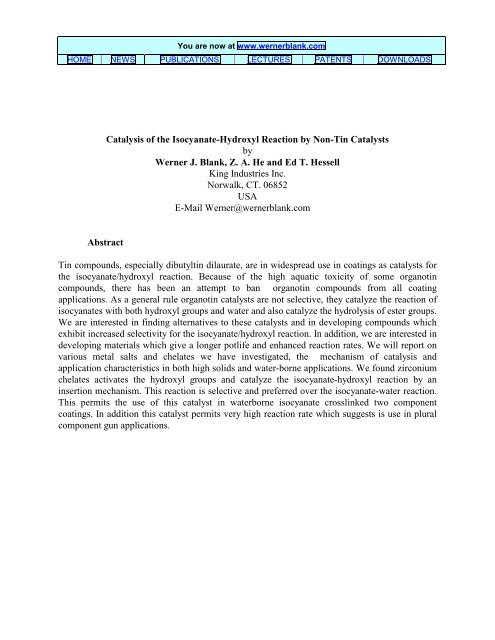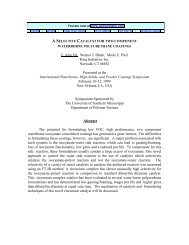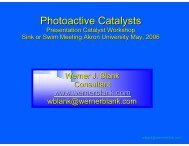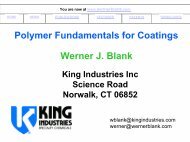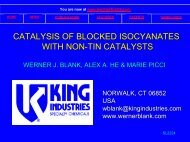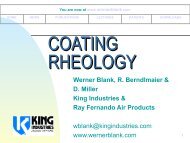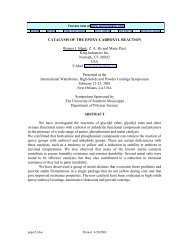Catalysis of the Isocyanate-Hydroxyl Reactions ... - Wernerblank.com
Catalysis of the Isocyanate-Hydroxyl Reactions ... - Wernerblank.com
Catalysis of the Isocyanate-Hydroxyl Reactions ... - Wernerblank.com
You also want an ePaper? Increase the reach of your titles
YUMPU automatically turns print PDFs into web optimized ePapers that Google loves.
You are now at www.wernerblank.<strong>com</strong><br />
HOME NEWS PUBLICATIONS LECTURES PATENTS DOWNLOADS<br />
<strong>Catalysis</strong> <strong>of</strong> <strong>the</strong> <strong>Isocyanate</strong>-<strong>Hydroxyl</strong> Reaction by Non-Tin Catalysts<br />
by<br />
Werner J. Blank, Z. A. He and Ed T. Hessell<br />
King Industries Inc.<br />
Norwalk, CT. 06852<br />
USA<br />
E-Mail Werner@wernerblank.<strong>com</strong><br />
Abstract<br />
Tin <strong>com</strong>pounds, especially dibutyltin dilaurate, are in widespread use in coatings as catalysts for<br />
<strong>the</strong> isocyanate/hydroxyl reaction. Because <strong>of</strong> <strong>the</strong> high aquatic toxicity <strong>of</strong> some organotin<br />
<strong>com</strong>pounds, <strong>the</strong>re has been an attempt to ban organotin <strong>com</strong>pounds from all coating<br />
applications. As a general rule organotin catalysts are not selective, <strong>the</strong>y catalyze <strong>the</strong> reaction <strong>of</strong><br />
isocyanates with both hydroxyl groups and water and also catalyze <strong>the</strong> hydrolysis <strong>of</strong> ester groups.<br />
We are interested in finding alternatives to <strong>the</strong>se catalysts and in developing <strong>com</strong>pounds which<br />
exhibit increased selectivity for <strong>the</strong> isocyanate/hydroxyl reaction. In addition, we are interested in<br />
developing materials which give a longer potlife and enhanced reaction rates. We will report on<br />
various metal salts and chelates we have investigated, <strong>the</strong> mechanism <strong>of</strong> catalysis and<br />
application characteristics in both high solids and water-borne applications. We found zirconium<br />
chelates activates <strong>the</strong> hydroxyl groups and catalyze <strong>the</strong> isocyanate-hydroxyl reaction by an<br />
insertion mechanism. This reaction is selective and preferred over <strong>the</strong> isocyanate-water reaction.<br />
This permits <strong>the</strong> use <strong>of</strong> this catalyst in waterborne isocyanate crosslinked two <strong>com</strong>ponent<br />
coatings. In addition this catalyst permits very high reaction rate which suggests is use in plural<br />
<strong>com</strong>ponent gun applications.
Introduction<br />
The catalysis <strong>of</strong> <strong>the</strong> isocyanate-hydroxyl reaction has been studied by many authors 1 who found<br />
that <strong>the</strong> reaction <strong>of</strong> aliphatic isocyanates with hydroxyl groups is catalyzed by many metal<br />
carboxylates and organo tin <strong>com</strong>pounds. t-Amine catalysis <strong>of</strong> <strong>the</strong> reaction <strong>of</strong> aromatic<br />
isocyanates with hydroxyl groups has been practiced for some time and is <strong>com</strong>mon for <strong>the</strong><br />
preparation <strong>of</strong> flexible polyurethane foams 2 . This paper also describes <strong>the</strong> formation <strong>of</strong><br />
isocyanurate trimer and <strong>the</strong> side reaction with water. This side reaction with water is a desirable<br />
reaction for foam applications because <strong>the</strong> thus formed carbon dioxide can be used as a blowing<br />
agent. In most coating applications side reaction with water is not desirable because it can lead to<br />
gassing and blister formation and also to poor crosslinking density. The water reaction <strong>of</strong><br />
isocyanates is especially troublesome during cure under high humidity conditions or in two<br />
<strong>com</strong>ponent water-borne isocyanate crosslinked coatings. The reaction <strong>of</strong> 4,4-<br />
dicyclohexylmethane diisocyanate in <strong>the</strong> presence <strong>of</strong> dialkyltin <strong>com</strong>pounds with water and<br />
alcohols was investigated 3 in triethylene glycol dimethyl e<strong>the</strong>r and n-methyl pyrrolidinone. This<br />
study found selectivity 4 <strong>of</strong> <strong>the</strong> hydroxyl versus water reaction <strong>of</strong> between 1.8 to 3.8 depending on<br />
reaction conditions. One exception was dibutyltin dichloride which gave equal rate constants for<br />
both n-butanol and water. The steric hindrance around <strong>the</strong> catalytic center was found to have<br />
strong effects on <strong>the</strong> rate constants for urethane reactions catalyzed by sulfonium catalysts 5 . In<br />
<strong>the</strong> cyclotrimerization reaction, this effect on <strong>the</strong> reaction rate was negligible. The reaction 6 <strong>of</strong><br />
isophorone diisocyanate with alcohols was studied in <strong>the</strong> absence and presence <strong>of</strong> dibutyltin<br />
dilaurate (DBTDL) and 1,4-diazabicyclo[2,2,2]-octane (DABCO). In <strong>the</strong> presence <strong>of</strong> DBTDL <strong>the</strong><br />
reaction <strong>of</strong> <strong>the</strong> secondary isocyanate groups was favored, while in <strong>the</strong> presence <strong>of</strong> DABCO <strong>the</strong><br />
reaction <strong>of</strong> <strong>the</strong> primary isocyanate group was preferred. Apparently <strong>the</strong> relative reactivity <strong>of</strong> <strong>the</strong><br />
isocyanate group depends on <strong>the</strong> mode <strong>of</strong> catalysis and steric hindrance. The reaction <strong>of</strong> water<br />
with aromatic polyisocyanates is <strong>of</strong> interest in <strong>the</strong> formation <strong>of</strong> polyurethane foams. This<br />
reaction 7 was studied in diglyme with amine and tin catalysts. Dibutyltin dilaurate and DABCO<br />
gave equal reaction rates with water and hydroxyl groups. Phenylmercuric acetate showed<br />
exceptional high reaction rates with water. Surprisingly only 70% <strong>of</strong> <strong>the</strong> water was found to<br />
contribute to carbon dioxide evolution. In water-borne two <strong>com</strong>ponent coatings 8 <strong>the</strong> formation <strong>of</strong><br />
urea is a major side reaction. The reaction <strong>of</strong> polyisocyanates in water-borne two <strong>com</strong>ponent<br />
coatings 9 in <strong>the</strong> presence <strong>of</strong> different amines was investigated. It was observed that <strong>the</strong> pK a value<br />
<strong>of</strong> <strong>the</strong> amine has a large effect on <strong>the</strong> water-isocyanate reaction and that amines with a higher pK a<br />
value show increased reactivity <strong>of</strong> <strong>the</strong> isocyanate with water.<br />
Dibutyltin <strong>com</strong>pounds are generally recognized to function as Lewis acid catalysts by<br />
<strong>com</strong>plexing with <strong>the</strong> isocyanate 10 . The mechanism <strong>of</strong> catalysis <strong>of</strong> amines has been related to<br />
Lewis base catalysis, <strong>the</strong> amine <strong>com</strong>plexing <strong>the</strong> alcohol. Indeed a synergistic effect 11 <strong>of</strong> tin<br />
<strong>com</strong>pounds with amines has been observed in urethane formation. The observation that <strong>the</strong><br />
urethane groups formed catalyze 12 <strong>the</strong> hydroxy/isocyanate reaction <strong>com</strong>plicates in establishing a<br />
catalysis mechanism.<br />
We were interested to develop a catalyst which predominately catalyzes <strong>the</strong> isocyanate-hydroxyl<br />
reaction and not <strong>the</strong> water-reaction. A suppression <strong>of</strong> <strong>the</strong> water reaction could permit <strong>the</strong><br />
formulation <strong>of</strong> water-borne isocyanate crosslinked coatings with an improved potlife, a reduction<br />
in <strong>the</strong> isocyanate index and also permit a reduction in variation in crosslink density with aging <strong>of</strong><br />
<strong>the</strong> formulation.
EXPERIMENTAL<br />
Zirconium dionate <strong>com</strong>plexes used in this study were prepared via ligand exchange reactions 13 <strong>of</strong><br />
zirconium <strong>com</strong>pounds with corresponding diketone chelating agents. The different dionate<br />
chelating agents were ei<strong>the</strong>r obtained from <strong>com</strong>mercial sources or were syn<strong>the</strong>sized via <strong>the</strong> Claisen<br />
reaction.<br />
Zirconium catalyst A (ZIRC A) is obtained by preparing a solution <strong>of</strong> a zirconium, tetrakis(2,4-<br />
pentanedionato-kO,kO')-, (SA-8-11''11''1'1'''1'1''') <strong>com</strong>plex (ZrAcAc) in 2,4-pentanedione with a<br />
metal content <strong>of</strong> 0.07 %. Zirconium catalyst B (ZIRC B)is a proprietary zirconium tetra-dionato<br />
<strong>com</strong>plex 14 in a reactive diluent with a metal content <strong>of</strong> 0.4 %. The o<strong>the</strong>r chelating agents used in <strong>the</strong><br />
study are identified in <strong>the</strong> Results Section.<br />
The aluminum chelate catalyst used in this study is an aluminum, tris(2,4-pentanedionato-kO,kO')-,<br />
(OC-6-11) <strong>com</strong>plex 15 identified as Alch1.<br />
The bismuth carboxylate catalyst (Bi oct.) used was a <strong>com</strong>mercially supplied 75 % solution <strong>of</strong><br />
bismuth tris(2-ethylhexanoate) 16 in 2-ethylhexanoic acid.<br />
The polyols and polyisocyanates used during <strong>the</strong> study were <strong>com</strong>mercial materials and were used<br />
without fur<strong>the</strong>r purification. We observed variations in <strong>the</strong> reaction rates <strong>of</strong> <strong>the</strong> “uncatalyzed<br />
reaction” <strong>of</strong> polyols with polyisocyanates as measured in gel time 17 . These variations in reaction<br />
rate were attributed to catalytic impurities in both <strong>the</strong> polyol and also <strong>the</strong> polyisocyanate and <strong>the</strong><br />
interaction <strong>of</strong> impurities with <strong>the</strong> catalyst. Most <strong>of</strong> <strong>the</strong> catalyzed reactions were conducted under<br />
conditions to minimize <strong>the</strong> effect <strong>of</strong> uncatalyzed catalysis. We also used in our study polyols or<br />
polyisocyanates from <strong>the</strong> same batch or we re-tested new batches for uncatalyzed rates. The gel test<br />
was performed by mixing <strong>the</strong> acrylic polyol 18 with <strong>the</strong> catalyst, adding <strong>the</strong> polyisocyanate (HDItrimer)<br />
crosslinker and sealing <strong>the</strong> blend in a vial. The vials were immersed in a water bath at 62ºC<br />
and checked for flow and gelation every 5-10 minutes.<br />
Cure studies were conducted on draw down films using a wire applicator. Cure conditions if not<br />
indicated were kept at 20-22ºC and 50-60 % <strong>of</strong> relative humidity (RH). Higher temperature cure<br />
studies were conducted in a forced air circulating electrically heated oven. The substrate was iron<br />
phosphated pretreated steel panels.<br />
Viscosity stability studies were conducted at room temperature (22-25°C) or at a higher temperature<br />
as shown in <strong>the</strong> Result Section in a small sample container. Viscosity was measured on a<br />
<strong>the</strong>rmostated Brookfield vis<strong>com</strong>eter equipped with a small sample cup at 25°C and <strong>the</strong> viscosity<br />
was continuously recorded.<br />
For drying time measurement, <strong>the</strong> liquid formulation containing polyisocyanate, polyol and<br />
catalyst was cast on a metal panel and <strong>the</strong> surface dry time and <strong>the</strong> through dry time were recorded<br />
with a circular Drying Time Recorder 19 .<br />
RESULTS<br />
In our initial screening study we used a <strong>com</strong>mercially available acrylic resin and hexamethylene<br />
diisocyanate isocyanurate trimer 20 (HDI-Trimer) as a crosslinker. As seen in Figure 1 many<br />
<strong>com</strong>pounds can catalyze <strong>the</strong> isocyanate reaction. The gel times in minutes are shown using a metal<br />
concentration <strong>of</strong> 0.01 % metal on <strong>the</strong> binder resin solids. Dionate indicates a metal dionate <strong>com</strong>plex<br />
with 2,4-pentanedione. Me acetac indicates a metal acetoacetate <strong>com</strong>plex. Me oct. are isooctate or<br />
2-ethylhexoate salts <strong>of</strong> <strong>the</strong> metal. Napt indicates <strong>the</strong> naph<strong>the</strong>nate salt. DBTDL is dibutyltin dilaurate<br />
and DBTDA is dibutyltin diacetate. We also screened antimony (III) acetate, zirconium octoate,<br />
calcium octoate, titanium tetrabutoxide, chromium (III) dionate and octoate and cerium which<br />
showed no catalytic activity. Under different reaction conditions we found titanium tetrabutoxide<br />
catalytically active but because <strong>of</strong> <strong>the</strong> extreme sensitivity to water <strong>the</strong> test results are very<br />
unpredictable. Both DBTDL and DBTDA showed excellent catalytic activity, closely followed by
<strong>the</strong> Zr tetrakis(2,4-pentanedionato) <strong>com</strong>plex. It is interesting to note that some <strong>of</strong> <strong>the</strong> metal<br />
<strong>com</strong>pounds are more catalytic as <strong>the</strong> carboxylate salts where o<strong>the</strong>rs are more reactive as <strong>the</strong><br />
pentanedionate <strong>com</strong>plex.<br />
Because <strong>of</strong> <strong>the</strong> high catalytic activity <strong>of</strong> <strong>the</strong> zirconium tetrakis(2,4-pentanedionato) <strong>com</strong>plex we<br />
decided to fur<strong>the</strong>r investigate its catalytic activity.<br />
Potlife and tack-free time <strong>of</strong> polyester/HDI-trimer uncatalyzed and with DBTDL, ZrAcAc<br />
catalyzed formulations 21 was determined. (Figure 2). Although <strong>the</strong> formulation containing <strong>the</strong><br />
ZrAcAc catalyst has a substantially shorter potlife that <strong>the</strong> DBTDL catalyzed system, <strong>the</strong> tack-free<br />
time was significantly larger, raising <strong>the</strong> question about potential deactivation <strong>of</strong> <strong>the</strong> catalyst in <strong>the</strong><br />
presence <strong>of</strong> moisture.<br />
NO CATALYST<br />
Al DIONATE<br />
Ce NAPHT<br />
Ti ACETAC<br />
Zn ACET<br />
Zn DIONATE<br />
Bi OCT.<br />
Zn OCT.<br />
Ti DIONATE<br />
Mn DIONATE<br />
Ni DIONATE<br />
Co OCT.<br />
Co DIONATE<br />
Zr DIONATE<br />
DBTDAc<br />
DBTDL<br />
0 100 200 300 400 500 600<br />
GEL TIME, MINUTES<br />
Figure 1 Acrylic Polyol/HDI-trimer 1/1 OH/NCO<br />
Nonvolatile 50 % in xylene/butyl acetate,<br />
Metal 0.009 % on binder. Temperature 62ºC<br />
Catalyst<br />
NO CAT<br />
Zr ACAC<br />
DBTDL<br />
1E0 1E1 1E2 1E3<br />
TIME, MINUTES<br />
2X VISC.<br />
TACK FREE<br />
SL2094<br />
Figure 2 Double viscosity and tack-free time,<br />
polyester/HDI-trimer, Catalyst 0.0065 % metal based on<br />
resin solids.<br />
Temperature 25ºC<br />
To increase <strong>the</strong> potlife and to counteract any potential hydrolysis <strong>of</strong> <strong>the</strong> ZrAcAc <strong>com</strong>plex we added<br />
2,4-pentanedione to <strong>the</strong> formulation equivalent to a 372, 744 and 1343 molar excess respectively.<br />
The results are shown in Figure 3. The surprising finding is an increase in <strong>the</strong> potlife <strong>of</strong> <strong>the</strong><br />
formulation and also an improvement in cure response.<br />
To gain fur<strong>the</strong>r insights in <strong>the</strong> reaction mechanism <strong>of</strong> catalysis we syn<strong>the</strong>sized a range <strong>of</strong> zirconium<br />
dionate <strong>com</strong>plexes with a variety <strong>of</strong> ligands. For <strong>the</strong> polyol/polyisocyanate <strong>com</strong>ponent we selected<br />
<strong>the</strong> acrylic resins used in <strong>the</strong> initial catalyst evaluation. Figure 4 shows <strong>the</strong> resulting gel, tack-free<br />
and dry-through time <strong>of</strong> a number <strong>of</strong> zirconium chelates and also <strong>com</strong>parative information on<br />
DBTDL and an <strong>the</strong> uncatalyzed formulation. Formulations which did not react after 600 minutes<br />
did not cure after 720 minutes and required between 12 to 24 hours for cure.<br />
Viscosity, minutes<br />
60<br />
50<br />
40<br />
30<br />
20<br />
10<br />
12<br />
10<br />
8<br />
6<br />
4<br />
2<br />
Tack Free, hours<br />
CATALYST<br />
ETH-ACAC<br />
ACETOAC<br />
Zr Butoxide<br />
BACAC<br />
NO CATALYST<br />
DBTDL<br />
ACAC<br />
TRIACAC<br />
TRIFACAC<br />
TMHD<br />
MHD<br />
0<br />
4 376 748 1347<br />
2,4 Pentanedione/Zr mole ratio<br />
2X visc (min)<br />
Tack Free (hrs)<br />
0<br />
SL2015F<br />
Figure 3. Polyester/HDI-trimer, time for double<br />
viscosity in minutes and tack-free time in hours.<br />
0 200 400 600<br />
TIME, MINUTES<br />
GEL TACK DRY<br />
Figure 4. Acrylic/HDI-trimer, gel, tack-free and drythrough<br />
time at room temperature. Me 0.0046 %.
Temperature 25ºC. Temperature 25ºC<br />
The structure <strong>of</strong> <strong>the</strong> chelating agents used is shown in Figure 5. The zirconium <strong>com</strong>plexes were<br />
obtained from <strong>the</strong>se ligands by reacting <strong>the</strong> zirconium alkoxide with 4 moles <strong>of</strong> <strong>the</strong> chelating agent<br />
and removing <strong>the</strong> alcohol formed by vacuum distillation. For some <strong>of</strong> <strong>the</strong> <strong>com</strong>plexes a diluent or<br />
solvent was used for <strong>the</strong> reaction.<br />
Figure 5. Structure <strong>of</strong> Ligands<br />
ACAC<br />
MHD<br />
TMHD<br />
BACAC<br />
O<br />
O<br />
O<br />
O<br />
O<br />
O<br />
O<br />
O<br />
2,4-pentanedione<br />
ACETOAC<br />
O O<br />
O<br />
6-methyl-2,4-heptadione 2,2,6,6-tetramethyl-3,5-<br />
heptanedione<br />
ET-ACAC<br />
TRIFACAC<br />
O O<br />
O O<br />
F<br />
1-Benzoylacetone<br />
TRIACAC<br />
O O<br />
ethyl acetoacetate<br />
3-ethyl-2,4-<br />
pentanedione<br />
F F<br />
1,1,1-trifloro-2,4-<br />
pentanedione<br />
O<br />
Triacetyl methane<br />
The gel time <strong>of</strong> acrylic/HDI trimer formulations catalyzed with ZIRC A & B and DBTDL are<br />
reported in Figure 6.<br />
420<br />
180<br />
360<br />
GEL TIME (min)<br />
120<br />
60<br />
GEL Time (min)<br />
300<br />
240<br />
180<br />
120<br />
60<br />
0<br />
0 0.01 0.02 0.03<br />
CATALYST CONCENTRATION (Me, %)<br />
0<br />
0 0.1 0.2 0.3 0.4 0.5<br />
CATALYST CONC. (Me, %)<br />
ZIRC B ZIRC A DBTDL<br />
SL2073F<br />
Bi salt Al ch1<br />
SL2074F<br />
Figure 6 Gel time <strong>of</strong> acrylic/HDI trimer, gel time for<br />
ZIRC A&B and DBTDL. Temperature 25ºC.<br />
Figure 7. Gel time <strong>of</strong> acrylic/HDI trimer, gel time for<br />
bismuth and Alch1 catalyst. Temperature 25ºC.<br />
For <strong>the</strong> bismuth carboxylate and <strong>the</strong> Alch1 <strong>com</strong>pounds in Figure 7, <strong>the</strong> increased gel time <strong>of</strong> <strong>the</strong><br />
ZIRC A catalyst is due to <strong>the</strong> excess 2,4-pentanedione in this material.<br />
Tack-free time for ZIRC A & B and DBTDL is given in Figure 8 and for <strong>the</strong> bismuth and AlCh1<br />
catalyst in Figure 9.
300<br />
420<br />
TACK-FREE Time (min.)<br />
240<br />
180<br />
120<br />
60<br />
0<br />
0 0.005 0.01 0.015 0.02<br />
CATALYST CONC. Me %<br />
TACK-FREE TIME (min.)<br />
360<br />
300<br />
240<br />
180<br />
120<br />
60<br />
0<br />
0 0.1 0.2 0.3 0.4 0.5<br />
CATALYST, CONC. Me %<br />
ZIRC B ZIRC A DBTDL<br />
SL2077F<br />
Bi oct Al ch1<br />
SL2078F<br />
Figure 8. Tack-free time <strong>of</strong> acrylic/HDI trimer, gel time<br />
for ZIRC A & B and DBTDL<br />
Figure 9. Tack-free time <strong>of</strong> acrylic/HDI trimer, gel time<br />
for bismuth and Alch1 catalyst<br />
Figure 10 and 11 give <strong>the</strong> dry time for ZIRC A & B, DBTDL and for bismuth and AlCh1<br />
catalyst.<br />
DRY-THROUGH Time ( min.)<br />
420<br />
360<br />
300<br />
240<br />
180<br />
120<br />
60<br />
0<br />
0 0.005 0.01 0.015 0.02<br />
CATALYST, CONC Me %<br />
ZIRC B ZIRC A DBTDL<br />
DRY-THROUGH Time (min.)<br />
360<br />
300<br />
240<br />
180<br />
120<br />
60<br />
0<br />
0 0.1 0.2 0.3 0.4 0.5<br />
CATALYST CONC. Me, %<br />
Bi oct Al ch1<br />
SL2076F<br />
Figure 10. Dry-through time <strong>of</strong> acrylic/HDI trimer, gel<br />
time for ZIRC A&B and DBTDL<br />
Figure 11. Dry-through time <strong>of</strong> acrylic/HDI trimer, gel<br />
time for bismuth and Alch1 catalyst<br />
The time required for a doubling in viscosity for a polyester/HDI-trimer in <strong>the</strong> presence <strong>of</strong> DBTDL<br />
and AlCh1 catalyst in <strong>the</strong> presence <strong>of</strong> different levels <strong>of</strong> 2,4-pentanedione is shown in Figure 12.<br />
The catalyst level in <strong>the</strong> formulation for DBTDL is 0.0042 % Sn on resin and for AlCh1 is 0.052 %<br />
Al on resin. The level <strong>of</strong> 2,4-pentanedione was 0, 0.58, 1.23 and 1.8% on resin solids or a molar<br />
ratio <strong>of</strong> tin to pentanedione 0, 163, 345 and 505; for <strong>the</strong> aluminum chelate <strong>the</strong> ratio was 0, 3, 6.4<br />
and 9.3. The same experiment was also conducted for <strong>the</strong> bismuth catalyst and no increase in<br />
potlife was observed.<br />
The relative rate <strong>of</strong> reaction <strong>of</strong> n-butyl isocyanate with 2-ethylhexanol and water was measure by<br />
FT-IR in a THF solution using DBTDL and ZIRC A catalyst. The IR shows a clear reduction in<br />
urea formation with <strong>the</strong> ZIRC A catalyst <strong>com</strong>pared to DBTDL (Figure 13).
600<br />
540<br />
480<br />
420<br />
360<br />
300<br />
240<br />
180<br />
120<br />
60<br />
0<br />
1.8 1.23 0.58 0<br />
2,4-Pentanedione on Solids, %<br />
AlCh1 DBTDL SL2102<br />
Figure 12. Time to reach double viscosity for a DBTDL and<br />
AlCh1 catalyzed formulation, in <strong>the</strong> presence <strong>of</strong> 2,4-<br />
pentanedione. Temperature 25ºC.<br />
0.6<br />
0.5<br />
0.4<br />
0.3<br />
0.2<br />
0.1<br />
0<br />
-0.1<br />
1800<br />
1700<br />
1600<br />
WAVENUMBER CM-1<br />
ZIRC A<br />
UREA<br />
DBTDL<br />
1500<br />
Figure 13. FT-IR spectrum. Absorbance <strong>of</strong><br />
reaction product butyl isocyanate, 2-ethylhexanol<br />
and water molar ratio 1/1/2. Metal 0.01 %<br />
ACID NUMBER<br />
15<br />
10<br />
5<br />
0<br />
0 2 4 8 13 18<br />
TIME, WEEKS<br />
DBTDAC NO CATALYST ZIRC B<br />
ZIRC A BISMUTH AlCH1<br />
SL2072<br />
Figure 14. Hydrolysis <strong>of</strong> polyester resin in <strong>the</strong> presence<br />
<strong>of</strong> catalyst. Metal 0.1 %<br />
The effect <strong>of</strong> catalysts on <strong>the</strong> hydrolysis <strong>of</strong> a<br />
polyester resin was measured in a 90 %<br />
homogenous solution <strong>of</strong> a low molecular<br />
weight polyester resin in a water/<br />
methylethylketone blend at a 1/3 ratio. This<br />
corresponds to a ratio <strong>of</strong> water to ester groups<br />
<strong>of</strong> 1.5 to 1. The test was conducted at 50°C<br />
for 18 weeks (3000 hours). After this time<br />
<strong>the</strong> acid number <strong>of</strong> <strong>the</strong> solution was<br />
measured. The polyester had an acid number<br />
<strong>of</strong> less than 0.1 at <strong>the</strong> start <strong>of</strong> <strong>the</strong> test. The pH<br />
<strong>of</strong> <strong>the</strong> solution was slightly acidic, no<br />
adjustments were made during <strong>the</strong> test<br />
(Figure 14).<br />
A water-borne two <strong>com</strong>ponent isocyanate crosslinked coating was formulated with a <strong>com</strong>mercially<br />
available water-dispersed resin 22 and a HDI-trimer. The ratio <strong>of</strong> NCO to OH used was 1.3. The<br />
formulation was tested uncatalyzed, catalyzed with DBTDL (0.0074 % Sn on resin solids) and with<br />
ZIRC B (0.008 % Zr on resin solids).<br />
Table 1 Cure Response <strong>of</strong> Water-borne Two Component Coating<br />
Formulation<br />
COMPONENTS<br />
Part A Resin <strong>com</strong>ponent Weight, % Weight, %<br />
Polyester polyol (70 % solids in water) 41.3 41.3<br />
Water deionized (1) 9.3 9.3<br />
Flow and leveling agent 0.17 0.17<br />
Dibutyltin dilaurate (DBTL) 0.04 -------<br />
Part B (isocyanate/OH ratio 1.3/1)<br />
Polyisocyanate HDI-trimer 38.1 38.1<br />
ZIRC B diluted with a reactive diluent ------- 1.34<br />
Water deionized (2) 11.2 9.8<br />
Total 100.0 100.0
Components A and B were mixed on a high speed agitator and blended with <strong>the</strong> water (2).<br />
Film Properties Drying conditions 25ºC, 50-60 % relative humidity.<br />
Catalyst on Resin Solids No catalyst DBTDL ZIRC B<br />
Zirconium, % ------- ------- 0.008<br />
Tin, % ------- 0.0075 -------<br />
Aged before application, hours 0 0 0<br />
Paint appearance foam foam no foam<br />
Film properties<br />
Tack free (hours) 5 3.5 3.75<br />
Through dry (hours) 8 4.5 4.0<br />
Gloss, 20°, % 53.0 94.7 94.9<br />
Gloss, 60°, % 84.7 99.7 99.9<br />
Catalyst on Resin Solids No catalyst DBTDL ZIRC B<br />
Aged before application, hours 1 1 2<br />
Paint appearance foam 1 hour gel no foam<br />
Film properties<br />
Gloss, 20°, % 75.0 88.3<br />
Gloss, 60°, % 92.4 97.8<br />
Aged before application, hours 4<br />
Paint appearance<br />
foam<br />
Film properties<br />
Gloss, 20°, % 87.4<br />
Gloss, 60°, % 96.2<br />
Maximum potlife (hours)<br />
3 hours no foam<br />
The appearance <strong>of</strong> <strong>the</strong> coating from above formulation can be seen in Figure 15. The DBTDL<br />
catalyzed formulation was applied after ½ and hour, <strong>the</strong> ZIRC B formulation after mixing and after<br />
2 and 4 hours. DBTDL shows gassing in <strong>the</strong> film and poor flow after only ½ hour and gelled at 1<br />
hour. The ZIRC B formulation is stable for at least 4 hours. The relative humidity during <strong>the</strong><br />
application was 50-60 % and <strong>the</strong> temperature was between 20-25°C. Figure 16 shows <strong>the</strong> film<br />
appearance at 50 and 70 % humidity for ZIRC B and for DBTDL at 70 % RH. The DBTDL<br />
catalyzed films lose considerable gloss under <strong>the</strong> 70 % humidity conditions. The ZIRC B catalyzed<br />
film retains almost all <strong>the</strong> gloss at 70 % RH. At 90 % RH all films are essentially flat.<br />
Figure 15. Film appearance <strong>of</strong> water-borne two<br />
<strong>com</strong>ponent coating, film thickness 25 η. Cure conditions<br />
room temperature and relative humidity 50-60%. Catalyst<br />
ZIRC B and DBTDL.<br />
Figure 16. Film appearance water-borne two <strong>com</strong>ponent<br />
coating, film thickness 25 η. Cure conditions, room<br />
temperature and relative humidity 50 and 70 %, ZIRC B<br />
and DBTDL catalyst.
In an attempt to better understand <strong>the</strong> mechanism <strong>of</strong> <strong>the</strong> Zr(AcAc) 4 catalysis <strong>of</strong> <strong>the</strong><br />
isocyanate/hydroxyl reaction several NMR experiments were conducted with model <strong>com</strong>pounds.<br />
The initial experiments were aimed at determining <strong>the</strong> extent <strong>of</strong> interaction <strong>of</strong> <strong>the</strong> isocyanate and<br />
hydroxyl with <strong>the</strong> metal <strong>com</strong>plex.<br />
Figure 17. Zr(AcAc) 4 + 3 eq. n-butyl isocyanate in CDCl 3 solution at 25<br />
o C<br />
Addition <strong>of</strong> n-butyl isocyanate<br />
to a solution <strong>of</strong> Zr(AcAc) 4 in<br />
CDCl 3 at room temperature<br />
showed no broadening <strong>of</strong> any<br />
<strong>of</strong> <strong>the</strong> resonance associated<br />
with ei<strong>the</strong>r <strong>the</strong> metal <strong>com</strong>plex<br />
or <strong>the</strong> isocyanate. The results<br />
are shown in Figure 17. This<br />
indicates that <strong>the</strong>re is relatively<br />
little, if any, interaction<br />
between <strong>the</strong> isocyanate and <strong>the</strong><br />
Zr(AcAc) 4 .<br />
In contrast, addition <strong>of</strong> n-<br />
butanol to a d 8 -THF solution <strong>of</strong><br />
Zr(AcAc) 4 at room temperature<br />
results in broadening <strong>of</strong> all<br />
resonances <strong>of</strong> both <strong>the</strong> ligand<br />
and n-butanol in <strong>the</strong> 1 H-NMR<br />
spectrum.<br />
Figure 18. Zr(AcAc) 4 + 3 eq. n- butanol in d 8 -THF at 25 o C<br />
When <strong>the</strong> sample is cooled to -50 o C <strong>the</strong> resonances for both <strong>the</strong> Zr(AcAc) 4 and alcohol sharpen<br />
to <strong>the</strong>ir normal peak widths and two separate types <strong>of</strong> n-butanol are observed.
However, <strong>the</strong>re was no<br />
evidence in <strong>the</strong><br />
1 H NMR<br />
spectrum at low temperature <strong>of</strong><br />
a Zr-H bond. The rate <strong>of</strong><br />
exchange <strong>of</strong> <strong>the</strong> n-butanol into<br />
<strong>the</strong> <strong>com</strong>plex could be<br />
determined from <strong>the</strong><br />
temperature dependence <strong>of</strong> <strong>the</strong><br />
line widths.<br />
Figure 19. Zr(AcAc) 4 + 3 eq. n-butanol in d 8 -THF at -50 o C<br />
Figure 20. Zr(AcAc) 4 in d 8 -THF at 25 o C<br />
Comparison <strong>of</strong> <strong>the</strong> room<br />
temperature<br />
1 H spectrum <strong>of</strong><br />
Zr(AcAc) 4 (Figure 20) and n-<br />
butanol (Figure 21) with that<br />
<strong>of</strong> <strong>the</strong> corresponding spectrum<br />
at room temperature where n-<br />
butanol has been added shows<br />
that <strong>the</strong> presence <strong>of</strong> additional<br />
n-butanol causes significant<br />
broadening <strong>of</strong> all peaks. We<br />
also attempted to conduct a<br />
similar experiment with water<br />
instead <strong>of</strong> n-butanol. It was not<br />
possible to draw any<br />
conclusion from this<br />
experiment because <strong>of</strong><br />
hydrolysis <strong>of</strong> <strong>the</strong> zirconium<br />
<strong>com</strong>plex.<br />
Figure 21. n-butanol in d 8 -THF at 25 o C
DISCUSSION AND CONCLUSIONS<br />
<strong>Catalysis</strong> with Metal Salts and with Metal Complexes<br />
Many metal salts and chelates can catalyze <strong>the</strong> reaction <strong>of</strong> polyisocyanates with hydroxyl<br />
<strong>com</strong>pounds (Figure 1). Some metals (Zn, Co, Ni, Cr) show no change in catalytic activity<br />
between <strong>the</strong> carboxylate salt and <strong>the</strong> dionate <strong>com</strong>plex. For zirconium and aluminum only <strong>the</strong><br />
dionate <strong>com</strong>plex was catalytically active. On an equal metal basis ZrAcAc is about 3-5 times<br />
more active as a catalyst than DBTDA in reducing <strong>the</strong> gel time (Figure 2). Aluminum dionate<br />
<strong>com</strong>plexes on <strong>the</strong> o<strong>the</strong>r hand are substantially less active as catalysts. Tack-free time <strong>of</strong> <strong>the</strong><br />
ZrAcAc catalyzed formulation is about three times longer than with DBTDL. This observation<br />
indicates that some deactivation <strong>of</strong> <strong>the</strong> ZrAcAc <strong>com</strong>plex is taking place in thin films. Based on<br />
<strong>the</strong> poor solubility <strong>of</strong> <strong>the</strong> ZrAcAc <strong>com</strong>plex in most solvents and <strong>the</strong> potential for hydrolysis with<br />
water we ran additional experiments where we added free 2,4-pentanedione to <strong>the</strong> formulation.<br />
Not only is 2,4-pentanedione an excellent solvent, it also should reduce any hydrolysis <strong>of</strong> <strong>the</strong><br />
ZrAcAc <strong>com</strong>plex. As shown in Figure 3 increasing <strong>the</strong> ratio <strong>of</strong> 2,4-pentanedione to zirconium<br />
from 4 to 376 decreases <strong>the</strong> potlife from 45 to 22 minutes and at <strong>the</strong> higher ratio <strong>of</strong> 748 and<br />
1347 increases <strong>the</strong> potlife to 32 and 54 minutes respectively. The tack free time decreases as <strong>the</strong><br />
ratio <strong>of</strong> pentanedione is increased from 15 hours to 7, 5, 3 hours respectively. Increase in potlife<br />
<strong>of</strong> DBTDL catalyzed formulations on addition with 2,4-pentanedione is known and is practiced<br />
widely in high solids coatings. The ra<strong>the</strong>r erratic behavior <strong>of</strong> zirconium cannot be explained by a<br />
single mechanism. Hydrolysis <strong>of</strong> <strong>the</strong> zirconium catalyst according to equation (1) and<br />
polymerization to a polymeric form (eq. 2) could cause a reduction in reaction rate 23 .<br />
We had noticed in a separate study a lower reaction rate <strong>of</strong> Zr-dionate <strong>com</strong>plexes with a<br />
substitution <strong>of</strong>
Both Bi oct. and AlCh1 behave similarly in <strong>the</strong> tack-free test as already shown in <strong>the</strong> gel test.<br />
(Figure 9).<br />
Dry-trough times for both ZIRC A and ZIRC B are about equal and approximately at an equal<br />
metal level four times faster than for DBTDL. On a <strong>com</strong>parative basis, <strong>the</strong> dry-through times for<br />
Bi oct. and DBTDL are substantially slower but still acceptable for many applications. In<br />
subsequent experiments it was determined that <strong>the</strong> cure response <strong>of</strong> <strong>the</strong> Bi oct. catalyst could be<br />
substantially enhanced by choosing a less polar solvent. Bi oct. demands a ra<strong>the</strong>r non-polar<br />
environment to assure good catalytic activity. This exceptionally fast reaction with ZIRC B<br />
suggests that this catalyst can be used in plural <strong>com</strong>ponent spray applications where mixing <strong>of</strong><br />
<strong>the</strong> isocyanate and <strong>the</strong> polyol takes place at <strong>the</strong> gun. O<strong>the</strong>r applications are in <strong>the</strong> RIM area.<br />
Potlife <strong>of</strong> <strong>the</strong> Formulation<br />
For many applications batch mixing <strong>of</strong> <strong>the</strong> polyol and <strong>the</strong> polyisocyanate crosslinker is used in<br />
which case a reasonable potlife is required. In low solids coatings it is possible to achieve an<br />
acceptable potlife by using a lower functionality resin and a ra<strong>the</strong>r slow reaction system. Because<br />
<strong>of</strong> <strong>the</strong> lower concentration <strong>of</strong> functional groups at a low nonvolatile content <strong>the</strong> reaction rates in<br />
solution are ra<strong>the</strong>r slow. Upon solvent evaporation increase in <strong>the</strong> concentration <strong>of</strong> functional<br />
groups accelerates <strong>the</strong> reaction rates. Because <strong>of</strong> <strong>the</strong> much higher molecular weight <strong>of</strong> <strong>the</strong><br />
polymers used in low solids coatings only a low conversion <strong>of</strong> hydroxyl-isocyanate groups is<br />
required to built a sufficient crosslinked network to achieve a tack-free surface or dry through.<br />
In high solids coatings <strong>the</strong> concentration <strong>of</strong> functional groups in solution and in <strong>the</strong> film are very<br />
similar, we <strong>the</strong>refore cannot rely on a change in concentration to effect potlife and reactivity.<br />
Because <strong>of</strong> <strong>the</strong> lower molecular weight and also lower functionality <strong>of</strong> high solids coatings we<br />
also require higher conversions <strong>of</strong> functional groups to achieve tack-free and dry-through<br />
conditions.<br />
Addition <strong>of</strong> excess 2,4-pentanedione can improve <strong>the</strong> potlife as seen with ZIRC A catalyst.<br />
Fur<strong>the</strong>r improvements in potlife can be achieved with aluminum chelate (Alch1). Compared to<br />
DBTDL <strong>the</strong> potlife <strong>of</strong> a formulation can be substantially enhanced by addition <strong>of</strong> 2,4-<br />
pentanedione 24 . Both formulations were adjusted for an equal dry-through time <strong>of</strong> about 50<br />
minutes (Figure 12).<br />
Relative Reaction Rates <strong>Hydroxyl</strong>-Water<br />
As shown in Figure 13, n-butyl isocyanate preferentially reacts with <strong>the</strong> hydroxyl groups instead<br />
<strong>of</strong> water and <strong>the</strong> formation <strong>of</strong> polyureas is minimized in <strong>the</strong> presence <strong>of</strong> ZIRC A <strong>com</strong>pared to<br />
DBTDL. This selectivity <strong>of</strong> <strong>the</strong> isocyanate-hydroxyl reaction is not only <strong>of</strong> importance in <strong>the</strong><br />
evolving market for two <strong>com</strong>ponent water-borne isocyanate crosslinked coatings, but also in<br />
many high solids coatings. Blushing <strong>of</strong> high solids coatings at high humidity or even gassing is<br />
an <strong>of</strong>ten encountered problem with high solids isocyanate crosslinked coatings.<br />
Hydrolysis <strong>of</strong> ester group containing resins in <strong>the</strong> presence <strong>of</strong> dialkyltin catalysts is a problem for<br />
many polyester-urethane polymers on exposure to water. We have demonstrated that DBTDA<br />
and presumably, DBTDL, are very effective catalysts in increasing <strong>the</strong> hydrolysis <strong>of</strong> a polyester<br />
resin. Zirconium, aluminum chelate and also bismuth salts do not catalyze <strong>the</strong> hydrolysis<br />
reaction. This would indicate that <strong>the</strong>se catalysts can give improved resistance properties and also<br />
suggests <strong>the</strong>ir use in <strong>the</strong> preparation <strong>of</strong> polyurethane polymers.<br />
Because <strong>of</strong> <strong>the</strong> growing importance <strong>of</strong> water-borne two <strong>com</strong>ponent coatings we also investigated<br />
<strong>the</strong> use <strong>of</strong> a ZIRC B catalyst, since DBTDL gives very fast water reaction rates. In a high solids<br />
waterborne polyester/polyisocyanate coating a potlife <strong>of</strong> only 30 minutes is achieved with
DBTDL and almost immediate gassing due to carbon dioxide development is observed. Even <strong>the</strong><br />
uncatalyzed formulation has a tendency to foam. Even after 4 hours <strong>the</strong> ZIRC B catalyst gave<br />
acceptable films (Table 1). The appearance <strong>of</strong> <strong>the</strong> films is shown in Figure 15 and 16. In both<br />
formulations <strong>the</strong> catalyst levels were adjusted for equal tack-free and dry-through time. For <strong>the</strong><br />
ZIRC B catalyst good gloss is obtained even after a potlife <strong>of</strong> 4 hours. Some decrease in flow and<br />
leveling is noticed and <strong>the</strong>re is some formation <strong>of</strong> carbon dioxide bubbles. Although <strong>the</strong> gloss is<br />
still excellent for <strong>the</strong> DBTDL catalyzed formulation after a 30 minute potlife it is difficult to<br />
form a film wherein no CO 2 bubbles are included. Increasing <strong>the</strong> humidity from <strong>the</strong> normal<br />
relative humidity <strong>of</strong> 50-60 % to 70 % causes <strong>the</strong> ZIRC B catalyzed formulation to lose some<br />
gloss, while DBTDL catalyzed films show even lower gloss (Figure 16). We have also prepared<br />
films at 90 % humidity, <strong>the</strong>se films were flat and milky in appearance. This indicates that for<br />
ZIRC B we have a cure window in regard to relative humidity which in <strong>the</strong> upper range is<br />
approximately 70 %.<br />
Mechanism <strong>of</strong> <strong>Catalysis</strong> with Zirconium Chelate Catalyst<br />
The generally accepted mechanism proposed for <strong>the</strong> DBTDL catalyzed reaction <strong>of</strong> isocyanate and<br />
hydroxyl can be viewed as a Lewis acid type mechanism involving polarization <strong>of</strong> <strong>the</strong> carbonyl<br />
by <strong>the</strong> metal <strong>com</strong>plex followed by nucleophilic attack <strong>of</strong> <strong>the</strong> hydroxyl (Eq. 3).<br />
δ + δ -<br />
M + RN C O RN C O M<br />
RN<br />
O<br />
OR'<br />
+ M<br />
(3)<br />
H<br />
R'OH<br />
All <strong>of</strong> <strong>the</strong> 1 H NMR evidence for Zr(AcAc) 4 reported above suggests a mechanism which is<br />
significantly different from <strong>the</strong> standard Lewis-acid type mechanism. With <strong>the</strong><br />
Zr(AcAc) 4 /isocyanate/hydroxyl system, we postulate that <strong>the</strong> first step <strong>of</strong> <strong>the</strong> reaction involves<br />
<strong>the</strong> coordination <strong>of</strong> <strong>the</strong> alcohol to <strong>the</strong> metal center. Two possible types <strong>of</strong> coordination/activation<br />
are shown in (Eq. 4).<br />
(AcAc) 3 Zr-OR (AcAc) 4 Zr O<br />
a<br />
b<br />
R<br />
H<br />
(4)<br />
The NMR evidence favors structure b, an independent series <strong>of</strong> 1 H NMR experiments showed<br />
that <strong>the</strong> rate <strong>of</strong> exchange <strong>of</strong> deuterium from n-BuOD into <strong>the</strong> AcAc ligands <strong>of</strong> <strong>the</strong> Zr(AcAc) 4 is<br />
slow relative to <strong>the</strong> rate <strong>of</strong> <strong>the</strong> ligand exchange process. A reasonable mechanism is shown in Eq.<br />
5. The (AcAc) 3 ZrOR alcoholate formed reacts with <strong>the</strong> isocyanate forming an insertion <strong>com</strong>plex,<br />
which in <strong>the</strong> presence <strong>of</strong> alcohol forms <strong>the</strong> urethane and returns <strong>the</strong> alcoholate into <strong>the</strong> reaction<br />
sequence.
Zr(AcAc) 4<br />
+ROH<br />
-ROH<br />
(AcAc) 4 Zr<br />
O<br />
R<br />
H<br />
(fast)<br />
O<br />
+AcAc<br />
-AcAc<br />
R'N<br />
H<br />
OR<br />
(slow)<br />
(fast)<br />
(AcAc) 3 Zr<br />
OR<br />
R'NCO<br />
(5)<br />
+ROH<br />
(fast)<br />
O<br />
(AcAc) 3 Zr<br />
N<br />
R'<br />
O<br />
R<br />
(AcAc) 3 Zr<br />
OR<br />
(fast)<br />
R'N=C=O<br />
ACKNOWLEDGEMENT<br />
We would like to acknowledge <strong>the</strong> suggestions and information provided by Mr. John Florio, <strong>the</strong><br />
coating formulation work conducted by Ms. Marie Picci, Mr. Dave Malkin <strong>the</strong> NMR department<br />
<strong>of</strong> Yale University for <strong>the</strong>ir assistance in <strong>the</strong> NMR studies. We would also like to thank Dr. Len<br />
Calbo for pro<strong>of</strong>reading <strong>the</strong> paper and King Industries for permission to publish this paper.<br />
REFERENCES<br />
1 E. P. Squiller, J. W. Rosthauser, “<strong>Catalysis</strong> in Aliphatic <strong>Isocyanate</strong>-Alcohol <strong>Reactions</strong>”. Water-Borne and Higher<br />
Solids Coatings Symposium, New Orleans Feb. 1987, pg. 460-477.<br />
2 I. S. Bechera and F. P. Carroll, “Unusual Catalysts for Flexible Urethane Foams”, Journal <strong>of</strong> Cellular Plastics,<br />
March/April 1980.<br />
3 S. D. Seneker and T. A. Potter, “Solvent and Catalyst Effects in <strong>the</strong> Reaction <strong>of</strong> Aliphatic <strong>Isocyanate</strong>s with<br />
Alcohols and Water”. Water-Borne and Higher Solids Coatings Symposium, New Orleans Feb. 1989, pg. 369-376.<br />
4 Selectivity is defined as ratio <strong>of</strong> n-butanol to water rate constants.<br />
5 J. E Kresta, C. S. Shen and S. I Lin, “Steric and Solvation Effects in <strong>Catalysis</strong> <strong>of</strong> Urethanes”, Soc. Plast. Eng.,<br />
Tech. Pap. (1979), 25, pg. 435-8<br />
6 F. N. Jones, S. P. Pappas and Hiro-Kuni Ono, “Recent Developments in Crosslinking Chemistry”, Water-Borne<br />
and Higher Solids Coatings Symposium, New Orleans Feb. 1985, pg. 8-24.<br />
7 D. Ihms, J. O. St<strong>of</strong>fer “Effect <strong>of</strong> Catalysts on <strong>the</strong> Kinetics <strong>of</strong> <strong>the</strong> Water-Toluene Diisocyanate Reaction”. J. C. T<br />
Vol. 57, No. 722, March 1985, pg. 61-57.<br />
8 L. Kahl, M. Bock, E. Jürgens and H. J. Laas, “Aqueous Two Pack PU Clear Coats”, ECP. Nov. 1996, pg. 563-568.<br />
9 V. J. Tramontano and W. J. Blank “Novel Water-borne Polyurethane Dispersions: Advances in Ambient<br />
Crosslinking with Polyisocyanates”, Water-Borne, Higher-Solids, and Powder Coatings Symposium<br />
February 22-24, 1995, New Orleans, LA USA<br />
10 S. C. Reegen and K. C. Frisch J. Polm. Sci. A-1 part, 1970, p.2883
11 L. Thiele, R. Becker and H. Frommelt, Faserforschung u. Textiltechnik, Z. Polymerforschung, 28, 405, 1977<br />
12 S. A. Lammiman and R. S. Satchell, J. Chem. Soc. Perkin II, pg. 877<br />
13 R.C. Fay “Zirconium and Hafnium” in Comprehensive Coordination Chemistry, Vol.3, edited by Ge<strong>of</strong>frey Wikinson,<br />
1987, Pergamon Press, pg. 363.<br />
14 K-KAT ® XC-6212 a product <strong>of</strong> King Industries Inc. Norwalk, CT 06852, USA, US pat. 5,846,897<br />
15 A modification <strong>of</strong> this <strong>com</strong>pound with improved solubility is <strong>com</strong>mercially available as K-KAT ® XC-5218 a<br />
product <strong>of</strong> King Industries Inc. Norwalk, CT 06852, USA<br />
16 K-KAT ® 348 a product <strong>of</strong> King Industries Inc., Norwalk CT 06852, USA<br />
17 J. W. Britain and P. G. Gemainhardt, J. Appl. Polym. Sci., 4, 207, (1960)<br />
18 Joncryl 906 acrylic polyol, hydroxyl number <strong>of</strong> solids 94, nonvolatile 72 %, solvent MAK, a product <strong>of</strong> SC<br />
Johnson Polymer, Racine WI.<br />
19 Gardner Circular Drying Recorder DC-9601<br />
20 Desmodur N-3300 is a hexamethylene diisocyanate isocyanurate trimer, <strong>Isocyanate</strong> equivalent weight 183, Bayer<br />
Corporation, Pittsburgh PA.<br />
21 Desmophen 651A-65 and Desmophen R-221-75 at a solids weight ratio <strong>of</strong> 65/35 were used in this formulation.<br />
Desmophen 651A-65 is a polyester Desmophen R-221-75 a high solids polyester resin, 75% active, 386 g/eq<br />
(solids), , Bayer Corp.<br />
22 Adura 100 polyol is a product <strong>of</strong> Air Products and Chemicals, Allentown, PA<br />
23 King Industries study on reaction rates <strong>of</strong> Zr <strong>com</strong>plexes with different degree <strong>of</strong> substitution.<br />
24 J. Florio “Non-Tin Catalysts for Urethane Coatings”, Paints and Coatings, Oct. 1997


